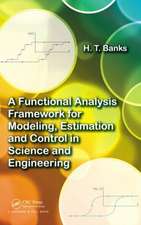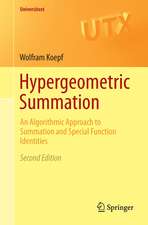A Concise Introduction to Analysis
Autor Daniel W. Stroocken Limba Engleză Paperback – 10 noi 2015
This book provides an introduction to the basic ideas and tools used in mathematical analysis. It is a hybrid cross between an advanced calculus and a more advanced analysis text and covers topics in both real and complex variables. Considerable space is given to developing Riemann integration theory in higher dimensions, including a rigorous treatment of Fubini's theorem, polar coordinates and the divergence theorem. These are used in the final chapter to derive Cauchy's formula, which is then applied to prove some of the basic properties of analytic functions.
Among the unusual features of this book is the treatment of analytic function theory as an application of ideas and results in real analysis. For instance, Cauchy's integral formula for analytic functions is derived as an application of the divergence theorem. The last section of each chapter is devoted to exercises that should be viewed as an integral part of the text.
A Concise Introduction to Analysis should appeal to upper level undergraduate mathematics students, graduate students in fields where mathematics is used, as well as to those wishing to supplement their mathematical education on their own. Wherever possible, an attempt has been made to give interesting examples that demonstrate how the ideas are used and why it is important to have a rigorous grasp of them.
Preț: 321.52 lei
Nou
Puncte Express: 482
Preț estimativ în valută:
61.53€ • 64.00$ • 50.80£
61.53€ • 64.00$ • 50.80£
Carte tipărită la comandă
Livrare economică 08-14 aprilie
Preluare comenzi: 021 569.72.76
Specificații
ISBN-13: 9783319244679
ISBN-10: 3319244671
Pagini: 218
Ilustrații: XII, 218 p.
Dimensiuni: 155 x 235 x 15 mm
Greutate: 0.33 kg
Ediția:1st ed. 2015
Editura: Springer International Publishing
Colecția Springer
Locul publicării:Cham, Switzerland
ISBN-10: 3319244671
Pagini: 218
Ilustrații: XII, 218 p.
Dimensiuni: 155 x 235 x 15 mm
Greutate: 0.33 kg
Ediția:1st ed. 2015
Editura: Springer International Publishing
Colecția Springer
Locul publicării:Cham, Switzerland
Public țintă
Lower undergraduateCuprins
Analysis on The Real Line.- Elements of Complex Analysis.- Integration.- Higher Dimensions.- Integration in Higher Dimensions.- A Little Bit of Analytic Function Theory.
Recenzii
“The uniqueness of the order and choice of topics makes the book an excellent resource and/or supplement to an introductory analysis course. Summing Up: Highly recommended. Upper-division undergraduates, graduate students, and researchers/faculty.” (J. T. Zerger, Choice, Vol. 54 (1), September, 2016)
“Goal of this book is to establish the principles of mathematical analysis both for functions of real variables and for functions of a complex variable in the shortest possible way. … book can be read and understood without resorting to any external reference since the author provides detailed proofs of all results. … in each chapter one can find several examples of the theory discussed as well as a list of working exercises that will be useful to the reader.” (Julià Cufí, zbMATH 1337.26001, 2016)
“Goal of this book is to establish the principles of mathematical analysis both for functions of real variables and for functions of a complex variable in the shortest possible way. … book can be read and understood without resorting to any external reference since the author provides detailed proofs of all results. … in each chapter one can find several examples of the theory discussed as well as a list of working exercises that will be useful to the reader.” (Julià Cufí, zbMATH 1337.26001, 2016)
Notă biografică
Before he retired, Stroock had been on the faculty of several universities, most recently M.I.T. The majority of his work has to do with analytic aspects of probability theory, especially the application of probability theory to partial differential equations. He is a member of the American Mathematical Society, the American Academy of Arts and Sciences, the National Academy of Sciences, and the Polish Academy of Arts and Sciences.
Textul de pe ultima copertă
This book provides an introduction to the basic ideas and tools used in mathematical analysis. It is a hybrid cross between an advanced calculus and a more advanced analysis text and covers topics in both real and complex variables. Considerable space is given to developing Riemann integration theory in higher dimensions, including a rigorous treatment of Fubini's theorem, polar coordinates and the divergence theorem. These are used in the final chapter to derive Cauchy's formula, which is then applied to prove some of the basic properties of analytic functions.
Among the unusual features of this book is the treatment of analytic function theory as an application of ideas and results in real analysis. For instance, Cauchy's integral formula for analytic functions is derived as an application of the divergence theorem. The last section of each chapter is devoted to exercises that should be viewed as an integral part of the text.
A Concise Introduction to Analysis should appeal to upper level undergraduate mathematics students, graduate students in fields where mathematics is used, as well as to those wishing to supplement their mathematical education on their own. Wherever possible, an attempt has been made to give interesting examples that demonstrate how the ideas are used and why it is important to have a rigorous grasp of them.
Caracteristici
Unique owing to its conciseness and brevity of the subject matter Contains topics unusual in other texts at this level, such as the proof of the prime number theorem Covers polar coordinates and the divergence theorem, applying these to derivation of Cauchy's integral formula













